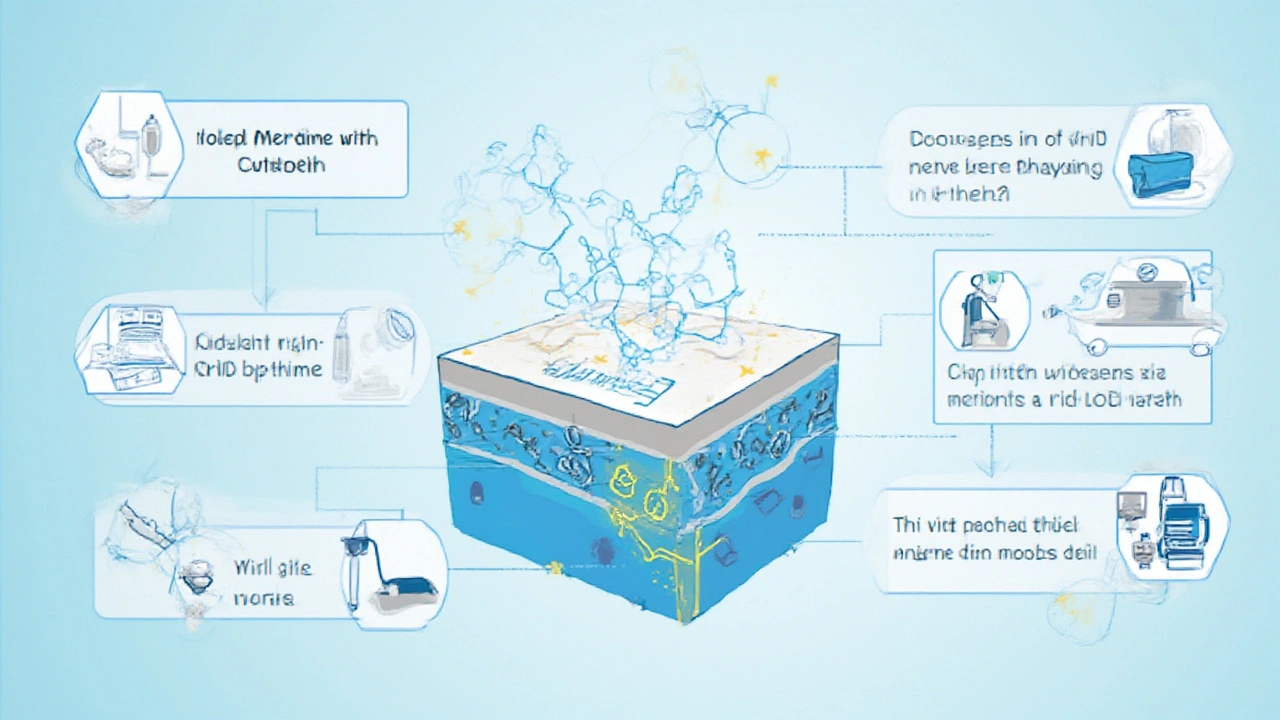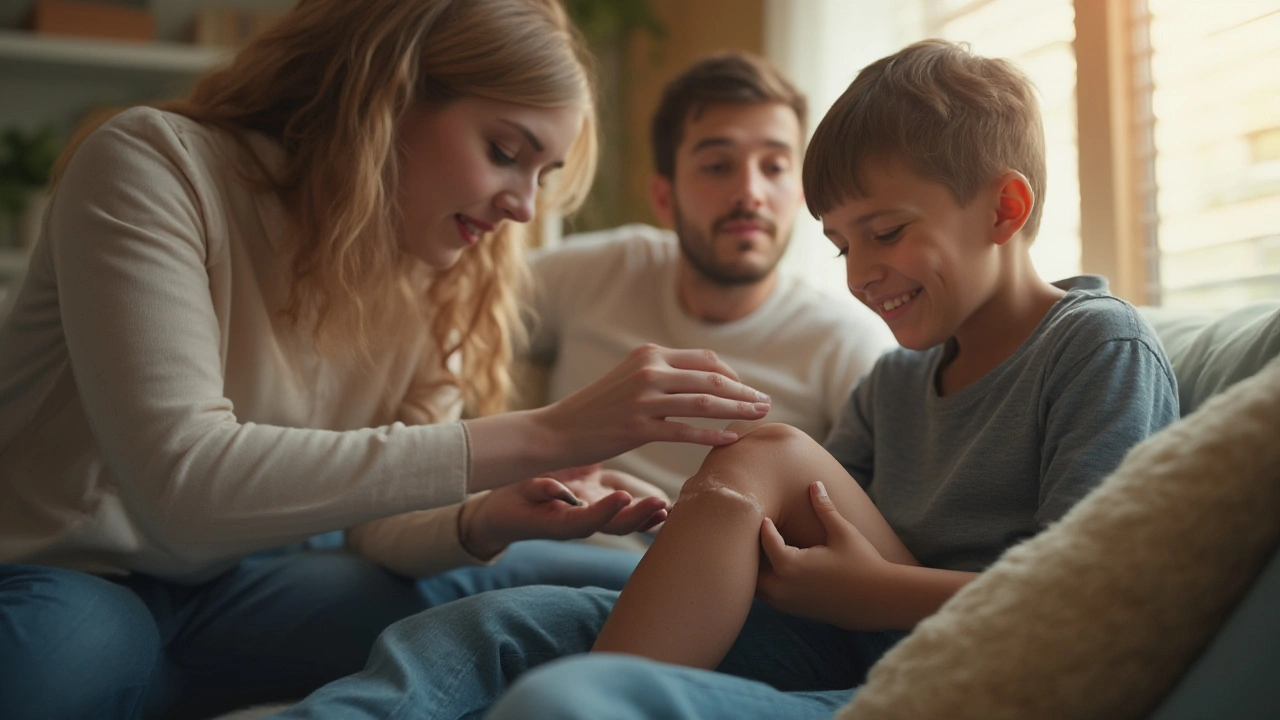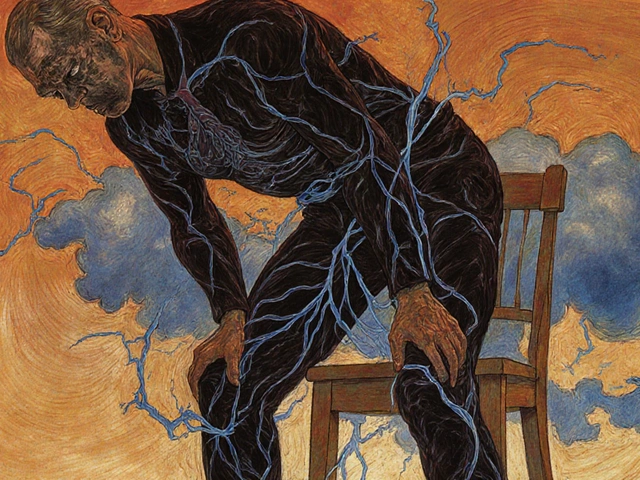Picture this: you’ve gashed your finger in the kitchen, and the pain is so sharp you can’t even look at it without wincing. Or maybe you’ve got a kid with a scraped knee who dreads every time you mention cleaning the wound. For all those moments when pain just makes injuries worse, lidocaine is the secret weapon that’s been quietly saving the day in clinics, homes, and hospitals for decades. Not only can it take the edge off that initial sting, but it can also make proper wound care possible—because let’s face it, nobody wants to scrub or dress a raw wound if it hurts too much to get close.
How Lidocaine Works Its Magic
Lidocaine might sound like something out of a science lab, but it’s been around since the 1940s, making life easier for people handling everything from paper cuts to surgical procedures. What’s so unique about lidocaine? It’s a fast-acting local anesthetic, which basically means it numbs a specific area without knocking you out or dulling your mind. Once applied to the skin, lidocaine blocks nerve signals in the area, making the pain disappear—sometimes in less than a minute.
If you’re curious about why lidocaine gives such instant relief, it stops your nerves from sending those "ouch!" signals up to your brain by blocking voltage-gated sodium channels. That stops the sharp, burning, or throbbing pain that makes even a minor scrape unbearable. It’s not some general painkiller for your whole body like ibuprofen; it targets the exact spot you need it, so you stay clear-headed but pain-free where it matters most.
You’ll often see lidocaine in creams, gels, sprays, and even patches. In clinics, doctors sometimes use injectable lidocaine for stitching up cuts or before minor skin surgeries. But in most homes and first-aid kits, it’s the topical form that’s king. There’s a good reason for that—topical lidocaine works in just a few minutes and doesn’t require special equipment. Walk into any pharmacy, and you’ll probably see it on the shelf under names like Solarcaine, Lidoderm, or just plain “lidocaine cream.”
One cool fact: in a 2020 clinical review, researchers found that using lidocaine cream or gel before wound cleaning could reduce reported pain scores by as much as 70%. That doesn’t just make people more comfortable; it lets healthcare workers actually clean out debris, disinfect the area, and apply bandages without a fight. If you’ve ever tended a wound on a screaming child or a nervous adult, you know what a big deal that is.
But here’s the twist—lidocaine only works on certain types of wounds. It’s perfect for burns, abrasions, grazes, minor cuts, or after skin procedures like laser treatments. It isn’t a fix for deep, puncture wounds or bites where numbness can hide trouble (like infection or foreign objects). Also, it works best where the skin is thin and the nerves are close to the surface—goodbye pain on a scraped shin, but maybe less effective on a big, deep wound in the muscle or fat.
Ready for a wild statistic? The World Health Organization considers lidocaine one of the safest, most essential medicines—right up there with penicillin and insulin. Its side effects are rare when used correctly, but that doesn’t mean you can slather it everywhere. Using too much at once, or putting it on big open wounds for long times, can lead to some serious problems, including dizziness, heart problems, or even seizures. That’s why the FDA strictly limits how strong over-the-counter lidocaine products can be. If you’re using a prescription-strength formula or injectable lidocaine, only a trained healthcare worker should handle it.
For minor cuts and scrapes, though, lidocaine is a first-aid favorite. Just don’t mix it up with other numbing agents unless a doctor says it’s safe, because your body can only handle so much anesthetic at a time.
| Form | Time to Work | Duration | Common Use |
|---|---|---|---|
| Cream/Gel | 2-5 minutes | 30-60 minutes | Minor burns, scrapes |
| Spray | 1-3 minutes | 15-30 minutes | Abrasions, sunburns |
| Patch | 10-30 minutes | Up to 8 hours | Nerve pain, chronic wounds |
| Injection | Immediate | 30-90 minutes | Suturing, deeper wounds |

When to Use Lidocaine in Wound Care—and When Not To
So, should you reach for lidocaine every time there’s a cut or scrape? Not so fast. The best time to use lidocaine is when wound pain is stopping you from cleaning, dressing, or healing the injury. Pain isn’t just annoying—it can make someone avoid care and slow recovery. Research shows that up to 80% of people with painful wounds do not clean the wound thoroughly because it hurts too much, raising the risk of infection. Lidocaine smooths the path to better care by turning a painful ordeal into a tolerable one.
Got a kid who won’t let you near road rash? A nervous older parent who gets skin tears easily? Lidocaine can mean the difference between a clean wound and one that festers. It’s also incredibly helpful for people with chronic skin conditions—think eczema, shingles, or diabetic ulcers—where pain gets in the way of everyday bandaging and gentle cleaning.
But it’s not for every situation. If you have a puncture wound, animal bite, or a deep laceration, don’t use topical lidocaine. You could mask danger signs like trapped dirt, expanding infection, or blood vessel damage. For wounds covered in ointment or dirt, always clean gently with saline or water first; lidocaine won’t work well on top of goo or grime. Also, don’t use lidocaine on larger wounds (those bigger than your palm) unless your doctor has checked them and said it’s okay.
Certain people should steer clear of lidocaine entirely. That list includes people who are allergic to “-caine” anesthetics (often they know from dentist visits), pregnant women using high doses, those with serious heart conditions, liver problems, or kids under 2 unless a doctor gives the green light. For everyone else, the key is to follow the instructions—don’t use more than the label says, and never wrap the treated area tightly, since that can boost lidocaine absorption and invite trouble.
If the wound keeps hurting after the lidocaine has worn off, or if you see spreading redness, foul odor, swelling, or fever, skip the numbing cream and get professional help. No over-the-counter solution can fix an infected or complicated wound—and lidocaine can sometimes mask symptoms you need to pay attention to.
- Use only on clean skin—remove blood and dirt first.
- Apply a thin layer just to the affected area, not surrounding healthy skin.
- Wait a minute for numbness to set in before cleaning or re-dressing the wound.
- Store creams or gels in a cool place—heat can weaken them.
- Never use with a heating pad or wrapped under plastic, which boosts absorption to unsafe levels.
Remember, wound pain isn’t just physical—it adds stress, anxiety, and sometimes stops kids, adults, and seniors from following through with good self-care. Fast-acting numbness can turn a dreaded moment into a quick, tolerable cleanup. It even helps out in the hospital: studies from 2023 proved that using lidocaine before IV starts, stitches, or minor surgical drains cut complaints in half, especially in kids and anxious adults.

Lidocaine in the Big Picture: Healing, Safety, and Smart Use
It’s not just about numbing pain for the moment. Lidocaine also lets wounds heal faster thanks to better daily care. Who wants to air out a nasty burn if touching it feels like torture? When pain stops being the main hurdle, people actually stick to cleaning and bandage routines, leading to lower infection rates and less scarring. This isn’t just hearsay—a big 2022 study from Johns Hopkins found that adding topical lidocaine to a wound-care protocol improved healing times by almost a week in people dealing with moderate abrasions and burns compared to those who didn’t use pain relief.
Safety tops the list when we’re talking about anesthetic creams. If you’re using store-bought 2-5% lidocaine formulas on small cuts and scrapes, risks are low for most people. But higher concentrations (like prescription 10% patches or injectable lidocaine) should always be supervised by a healthcare pro. In rare cases, using too much can lead to “lidocaine toxicity,” which starts out mild—dizziness, ringing in the ears, or drowsiness—but can progress to irregular heartbeat, numb tongue, and even seizures if ignored. That’s why you never, ever slather it onto huge wounds, pour it into cavities, or use it for anything it wasn’t meant for (and please, never put it in your mouth or eyes unless the packaging says you can!).
Did you know some people are wildly sensitive to local anesthetics? Maybe you’ve heard scary stories about folks allergic to the numbing shot at the dentist’s. True lidocaine allergy is rare, but not impossible. First-timers should always try a tiny amount on an unbroken patch of skin to check for burning, rash, or swelling. If any of those happen, stop right away and see a doctor. For most, though, lidocaine allergy is less common than, say, a reaction to bee stings or antibiotics.
One thing that’s changed the wound-care landscape in the last five years: “combination dressings.” These are fancy bandages that contain low-dose lidocaine along with hydrogel or silver for infection-fighting power. Some brands boast that they speed up healing while keeping pain at bay for up to 48 hours. The data is still rolling in, but these combo dressings are a game-changer for chronic wounds or burns that need frequent dressing changes.
What about emergencies? Paramedics often carry lidocaine gel in trauma kits—it helps quickly numb road rash, gravel burns, or skin injuries at accident scenes so they can clean up wounds without extra pain. And post-surgery? Plenty of folks get a prescription patch or cream for painful stitches or slow-healing areas, cutting down on the need for oral painkillers (and their side effects, like drowsiness or stomach upset).
Here are some practical tips for getting the most out of lidocaine in wound care:
- If you’re using a gel, cream, or spray, apply only a thin layer—thicker layers don’t work faster but can raise the risk of side effects.
- Kids and seniors usually need smaller amounts and lower strengths. Never give adult-strength products to children unless a doctor approves it.
- Always wash your hands after applying lidocaine. Even trace amounts left on fingers can accidentally numb lips, eyes, or other spots you touch later.
- If the pain comes back before reapplication is allowed, use a cool, damp cloth or talk to your pharmacist instead of adding another dose.
- Store lidocaine out of reach of kids and pets. Accidentally swallowing the gel can lead to dangerous side effects.
With all this said, lidocaine isn’t magic—it doesn’t heal wounds itself or prevent infection, and it’s no substitute for gentle cleaning, dry bandages, and keeping wounds covered to avoid picking or scratching. But when pain is the main thing holding someone back from good care, there’s no reason to suffer unnecessarily. Fast, smart, and safe numbness has changed the game in wound care, making life a little less painful for everyone who just wants to get back on their feet after an injury.






Sarah McCabe
Been using lidocaine gel on my kid's scrapes since he started climbing everything 😅 honestly life-changing. No more tears during cleaning, just a quick dab and he's chill. Pharmacy brands work fine, no need for fancy stuff.
Ron Prince
Lidocaine? Please. Real Americans use ice and grit. If you can't handle a little pain, maybe you shouldn't be handling sharp objects. This whole 'numb your pain' culture is why we're weak. Back in my day, we just sucked it up and washed wounds with soap and water. No chemicals needed.
King Splinter
Okay but let’s be real - this whole article reads like a pharmaceutical ad written by someone who’s never actually held a Band-Aid. Lidocaine doesn’t 'heal' anything. It just makes you ignore the fact that you didn’t clean the wound properly. Also, 70% pain reduction? Where’s the control group? Who funded this 'study'? Probably Johnson & Johnson. And don’t get me started on the patch thing - if you’re putting a patch on a scrape, you’re doing it wrong. Just use the cream. Or better yet, don’t use anything. Let the pain teach you a lesson.
Kristy Sanchez
Wow. So we’re just supposed to believe that a chemical that blocks sodium channels is somehow a 'secret weapon'? Like, cool. So is fire. So is gravity. But neither of those fix your stupid decision to grab a knife while distracted by TikTok. Also, I once put lidocaine on a sunburn and then touched my eye. Let me tell you, that was a whole experience. Don’t be that person. Also, 'essential medicine'? Says who? WHO? The same people who thought chloroquine was a cure for COVID? 🤡
Michael Friend
This is why America is collapsing. We’ve turned every minor injury into a medical emergency. Lidocaine? For a paper cut? What’s next, a spinal tap before brushing your teeth? People don’t need numbing cream. They need discipline. And maybe to stop being so damn dramatic about everything. I’ve had stitches without anything and lived to tell the tale. You’re not special. Your pain isn’t special. Stop medicating your incompetence.
Jerrod Davis
It is imperative to note that the utilization of topical lidocaine, while ostensibly efficacious in mitigating nociceptive stimuli, must be subjected to stringent clinical oversight. The absence of regulatory compliance in over-the-counter formulations presents a non-trivial risk of systemic toxicity, particularly in pediatric and geriatric populations. Furthermore, the conflation of symptomatic relief with therapeutic intervention constitutes a fundamental misapprehension of wound pathophysiology. One is advised to consult a licensed medical professional prior to deployment of any anesthetic agent in non-sterile environments.
Dominic Fuchs
Interesting how we’ve turned pain into something to be eradicated rather than understood. Lidocaine’s not magic, it’s a pause button. But maybe the real question is why we’re cutting ourselves so often in the first place. I once had a wound that took three weeks to heal because I kept touching it out of anxiety. Lidocaine wouldn’t have fixed that. Just needed to breathe. Still, it’s useful. Just don’t confuse comfort with healing. 🤷♂️
Asbury (Ash) Taylor
Let’s celebrate the quiet heroes of medicine - lidocaine among them. It doesn’t make headlines, but it lets a child get a bandage on without screaming. It lets an elderly person care for their own wounds with dignity. It’s not about avoiding pain - it’s about preserving peace. And peace? That’s what lets healing happen. Keep it simple. Keep it safe. Keep it in the first-aid kit. You’ve got this.
Kenneth Lewis
lol i used lidocaine spray on a burn and accidentally sprayed my hand then touched my nose and for like 20 min i couldnt smell anything. also it tasted like metal. not recomended. also why is there a table? who uses tables in reddit posts? 😂
Jim Daly
they say lidocaine is safe but i saw a guy on youtube put it on his whole back and passed out. like bro its not lotion. its not a body mist. its a drug. stop being dumb. also why does everyone act like this is new? my grandpa used it in the 70s. same stuff. same warnings. same people ignoring them.
Tionne Myles-Smith
I just want to say thank you for writing this. My mom has diabetic ulcers and she was terrified to clean them because it hurt so bad. We started using lidocaine cream and it changed everything. She actually started doing her own care again. No more crying. No more avoiding it. Just quiet, calm healing. It’s not glamorous, but it’s real. And it matters.
Leigh Guerra-Paz
Oh my goodness, this is so important! I can’t tell you how many times I’ve seen people avoid wound care because of pain - and then it gets infected! Lidocaine isn’t a crutch - it’s a bridge! A gentle, numbing bridge to better healing! And please, please, please - if you’re using it on a child, use the smallest amount possible, and always wash your hands after - I once touched my toddler’s eye with lidocaine-covered fingers and let me tell you, the screaming was louder than a fire alarm! 😭 But still - use it wisely, and it’s a miracle!
Jordyn Holland
Of course the internet is thrilled about a chemical that masks pain instead of addressing why you got injured in the first place. You’re not healing - you’re just avoiding the consequences of your own negligence. Next you’ll be asking for a pain-free vaccine. Or maybe a numbing cream for your bad decisions. The real tragedy isn’t the wound - it’s the culture that treats discomfort as a medical emergency.
Ron Prince
And yet here we are, a nation of crybabies, medicating every scrape like it’s a war wound. You don’t need a cream to clean a cut. You need a spine. But sure, keep slathering that chemical on. Maybe next you’ll want a pain-free breakup.